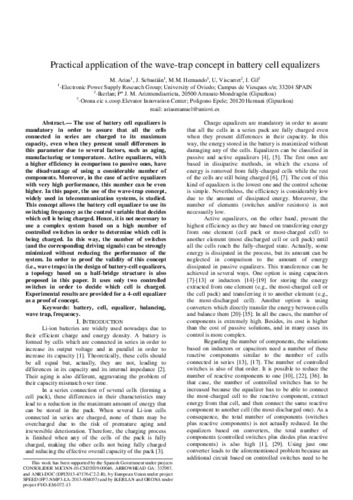Practical application of the wave-trap concept in battery-cell equalizers
Subject:
Battery
Cell
Equalizer
Balancing
Publication date:
Editorial:
IEEE
Publisher version:
Citación:
Descripción física:
Abstract:
The use of battery–cell equalizers is mandatory in order to assure that all the cells connected in series are charged to its maximum capacity, even when they present small differences in this parameter due to several factors, such as aging, manufacturing, or temperature. Active equalizers, with a higher efficiency in comparison to passive ones, have the disadvantage of using a considerable number of components. Moreover, in the case of active equalizers with very high performance, this number can be even higher. In this paper, the use of the wave-trap concept, widely used in telecommunication systems, is studied. This concept allows the battery–cell equalizer to use its switching frequency as the control variable that decides which cell is being charged. Hence, it is not necessary to use a complex system based on a high number of controlled switches in order to determine which cell is being charged. In this way, the number of switches (and the corresponding driving signals) can be strongly minimized without reducing the performance of the system. In order to proof the validity of this concept (i.e., wave traps) in the design of battery–cell equalizers, a topology based on a half-bridge structure is also proposed in this paper. It uses only two controlled switches in order to decide which cell is charged. Experimental results are provided for a four-cell equalizer as a proof of concept
The use of battery–cell equalizers is mandatory in order to assure that all the cells connected in series are charged to its maximum capacity, even when they present small differences in this parameter due to several factors, such as aging, manufacturing, or temperature. Active equalizers, with a higher efficiency in comparison to passive ones, have the disadvantage of using a considerable number of components. Moreover, in the case of active equalizers with very high performance, this number can be even higher. In this paper, the use of the wave-trap concept, widely used in telecommunication systems, is studied. This concept allows the battery–cell equalizer to use its switching frequency as the control variable that decides which cell is being charged. Hence, it is not necessary to use a complex system based on a high number of controlled switches in order to determine which cell is being charged. In this way, the number of switches (and the corresponding driving signals) can be strongly minimized without reducing the performance of the system. In order to proof the validity of this concept (i.e., wave traps) in the design of battery–cell equalizers, a topology based on a half-bridge structure is also proposed in this paper. It uses only two controlled switches in order to decide which cell is charged. Experimental results are provided for a four-cell equalizer as a proof of concept
Patrocinado por:
Spanish Government under Project CONSOLIDER [MICINN-10-CSD2009-00046]; Spanish Government under Project ARROW-HEAD [GA: 332987]; Spanish Government under Project ANRI-DOC [DPI2013-47176-C2-2-R]; European Union under Project SPEED [FP7-NMP3-LA-2013-604057]
Collections
Files in this item




